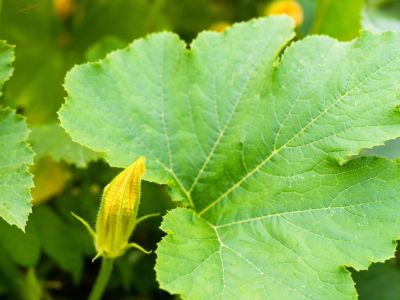Avid grazers know about the many wild plants nature provides for our recipes. But you don’t have to be a wild forager to enjoy some unique taste sensations in your recipes. Eating squash leaves provides many health benefits and may be enjoyed just like Swiss chard or spinach. Learn how to cook squash leaves for a quick, heart healthy meal.
Can You Eat Zucchini Leaves?
Squash leaves of many varieties provide a rich source of the Vitamins A, B, and C, as well as minerals like iron, calcium, zinc, potassium, and magnesium. Squash leaves have a scratchy exterior that isn’t entirely pleasant when eaten raw. For this reason, it is recommended that they are boiled, steamed, or stir-fried. The best leaves are the new, young ones, which are less fibrous than older foliage. Make sure the leaves are not harvested from a plant that has been sprayed with herbicides or pesticides. Collect leaves in the early morning when there is still dew on the foliage. Select leaves that are not bug eaten or sun scalded. Also avoid leaves with powdery mildew. The slender stems are also edible once cooked, but avoid the older, woody, stems. Early spring growth will provide the most toothsome leaves, but leave enough foliage on the plant for it to continue to harvest solar energy and grow.
Preparing Squash Leaves
Whether you are eating pumpkin leaves or another squash variety, preparation is the same. Wash the leaves thoroughly and dry them gently. It may be necessary to soak them in water to get all the dirt off and any small insects. Holding a leaf upside down, grasp the stem and pull it away from the rest of the leaf. The stem is hollow and you will be pulling strings from the center of the leaf. De-string all the leaves, which will be quite a bit. Squash leaves cook to nothing once they hit heat, much like spinach. Don’t worry about the rough hairs on the leaves. These will melt away after cooking, leaving a smooth mouth feel. You can choose to chop the leaves roughly or use them whole. Cleaned leaves will last in the refrigerator for a day or two when stored in a container lined with a damp paper towel, but it is best to use them as fresh as possible.
How to Cook Squash Leaves
The method you choose depends upon the recipe. If making a stir fry, add the leaves to the pan after any protein has been seared, and hard vegetables like carrots have softened. The leaves can be gently simmered for a few minutes in a tomato or other broth with herbs and seasonings. If using stems, blanch them briefly and then sauté in oil or butter with onions and garlic. Simmer leaves and stems in aromatics and coconut milk for an authentic Malaysian dish. Pumpkin greens are one of the sweeter squash greens, but you can also enjoy zucchini, yellow squash, butternut, and acorn leaves.
